By JEFFREY RESSNER
 Before the release of Titanic in 1997, moviegoers wondered how director James Cameron would depict the ship’s cataclysmic collision with an iceberg on its 1912 maiden voyage. However, once the film was released, the moments in which a young artist and a rebellious beauty surrender to their love proved perhaps even more memorable. The iconic scene of the lovers kissing on the bow of the doomed ocean liner was actually created at three separate locations and later pieced together to form one of the most romantic images in modern cinema.
Before the release of Titanic in 1997, moviegoers wondered how director James Cameron would depict the ship’s cataclysmic collision with an iceberg on its 1912 maiden voyage. However, once the film was released, the moments in which a young artist and a rebellious beauty surrender to their love proved perhaps even more memorable. The iconic scene of the lovers kissing on the bow of the doomed ocean liner was actually created at three separate locations and later pieced together to form one of the most romantic images in modern cinema.
The kiss itself was shot on a replica of the ship at the then-newly opened Baja Studios in Rosarito Beach, Mexico, where actors Leonardo DiCaprio and Kate Winslet stood by with the crew for over a week while Cameron waited for the background he wanted—“the kind of brooding sky that’s simultaneously beautiful and foreboding.” Other elements of the embrace were added with the actors posed on a viridescent platform against a green screen at Digital Domain in Venice, California. Finally, computer-generated characters as well as ship and sky depictions were composed by artists using powerful graphics software. Once the various segments were integrated, the CG lovers and painted sunset became indistinguishable from the real thing.
The three-minute scene on the bow was rendered with extreme precision during preproduction using storyboards, videomatics, and other planning tools to map out various angles and calibrate specific camera movements. But the perfectly hued sunset might be the most spectacular effect of all.
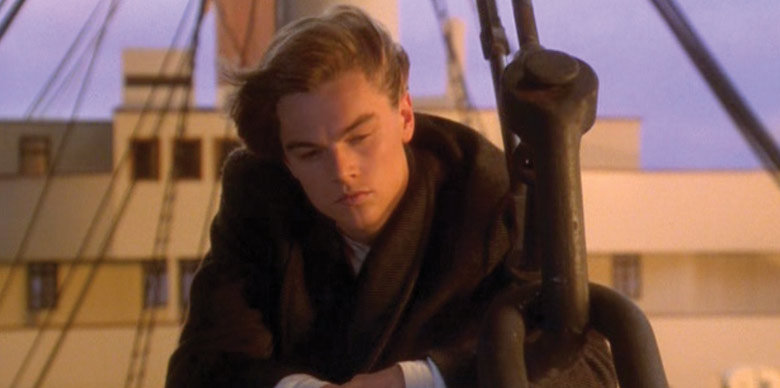
This medium shot of Leo is in front of a one-third scale miniature of the ship on a stage in Baja. It was actually a forced perspective set piece in which we had several full-scale elements in the foreground, like the mast and the rigging, while the two decks that are visible behind him were one-third scale, and we brought the scale back by compositing in several people. The passengers strolling around on the deck in the background were all added in as digital composite figures, green screen elements that were shot with a longer, focal-length lens from a distance on a stage at Digital Domain. We might have used some performance capture figures as well, because we were using them for wide shots.
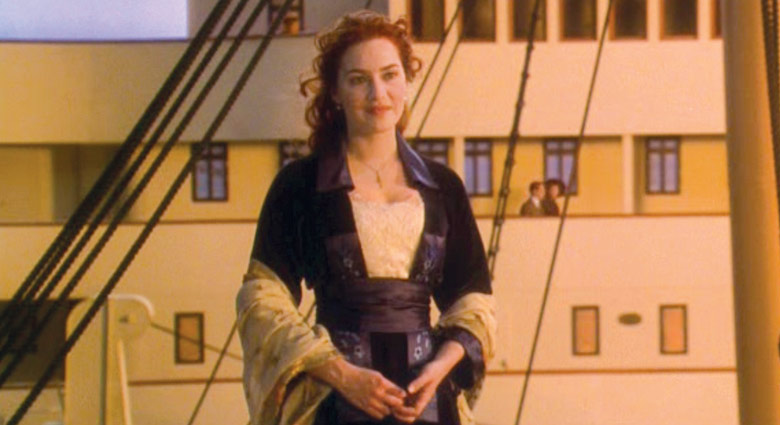
This slightly looser, cowboy shot of Rose, Kate Winslet’s character, was done on the same day we did the outdoor kiss. We just made up most of these shots on the set because they really didn’t require any storyboards or videomatics. The entire sequence pivots on the upcoming live shot of Jack and Rose at the railing together, where the sky is a stormy steel-grey-purple and he holds out her arms to simulate flying. I might have talked them through some of these timing cues up until the actual kiss, but I would never have shouted something like “OK! And now … kiss!” [laughs] It was nothing that specific. Kate and Leo would tell me what they wanted so they didn’t waste good work, but I wouldn’t overtalk a scene.
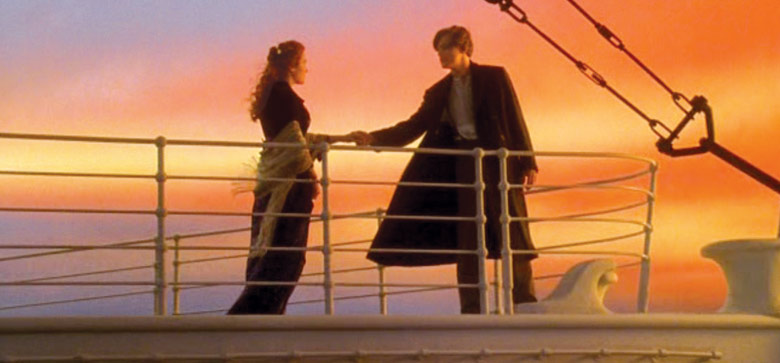
We had a mock-up of the entire bow section at Digital Domain. There was actually a large painted canvas here behind Jack and Rose. If you can visualize it: The set had a large painted backing on one axis, and on the other axis was the one-third-scale miniature of the ship’s superstructure. I never liked this painted backing, though, and it’s one of the few things I decided to change when we did the 3-D conversion last year—we updated the entire painting so it appeared more like a natural sky. To give credit where due, however, the art department whipped out that original painted backing over a single weekend. They gave it rock-all, but it wasn’t quite what it should have been.
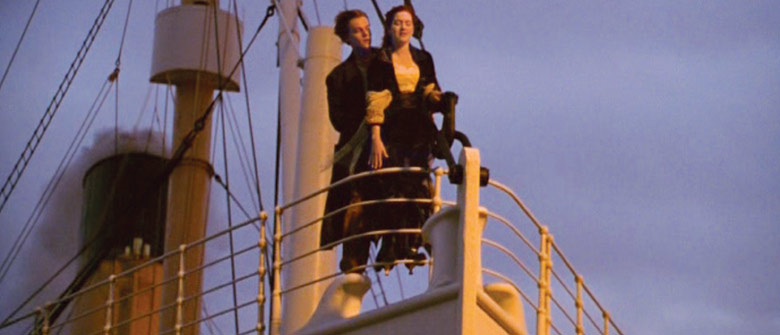
This frontal wide two-shot at the railing and the next frame are from the same take, the perfect alignment of all elements in which the camera moved in and we just hit pure gold. The wind happened to blow the smoke backwards out of the funnels beautifully. The lighting was spectacular, but there was no time for a rehearsal, so we just shot it. At the time we were shooting another scene, meaning Kate had to go through a complete wardrobe, wig and corset change, then race back to the set. When she jumped onto the ladder she took one look at the sun and turned and yelled at me as loud as she could, “SHOOT! SHOOT NOW!” [laughs] I’d never heard an actress do that before.
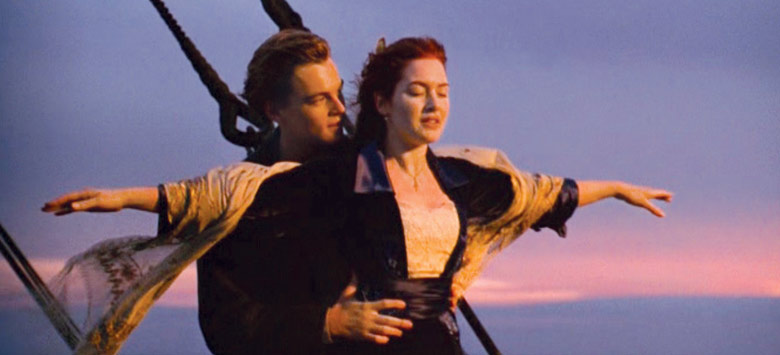
There was a lot of shouting and scurrying around because we had just minutes before the sun extinguished itself. We had given ourselves an eight-day window to shoot in the afternoons, which gave us eight bites at the apple to get a sunset. We had horrible, bald, blue skies seven days in a row, where the sun went down to the horizon with just no character whatsoever. On the eighth day we got an overcast sky, but I bet gaffer John Buckley and DP Russ Carpenter that the sun would come. They looked through their loupes and said it wouldn’t. I told them to get ready, and at the last second that warm salmon glow appeared on the horizon. The sun burst out and we got this incredible golden light on the actors.
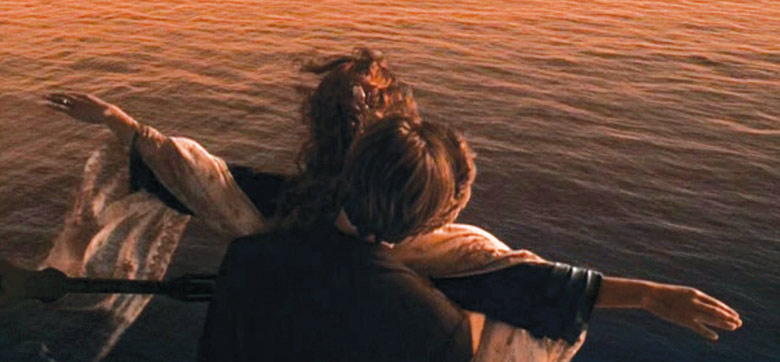
This over-the-shoulder, down-angle shot with Kate’s arms extended was done on a green screen stage and the water element was comped in digitally. We had gone over the kiss a month earlier. We rehearsed how we would do it, what the staging was, where the tentativeness was, where she would surrender to him, what the positioning would be. In the exterior shot the ‘flying’ has a very real quality because everything felt real to them, the ocean was right there, the wind was blowing, and they were 20 feet above the ground. Once we had the exterior shot done [in Baja], it was easy to fill in the scene.
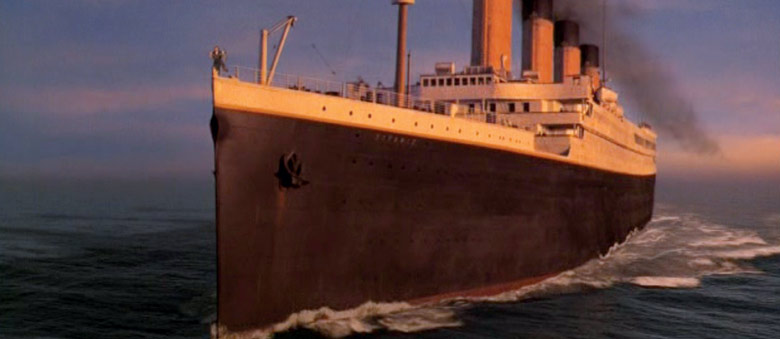
This is a big, complicated, motion control shot. There’s actually a live component to it, but a lot was done with digital doubles from a distance. We start very wide, and the figures are tiny CG figures. As we get closer, it morph-transitions into an actual stage element that continues into the next frame. The question I ask myself is: If we’d shot this entire scene 100 percent digitally, using actors and green screen and everything, could we have created that core sunset from scratch? I honestly don’t know. I might not have had the eye to create that one little strip of light, with sun completely out of frame. I might have gone instead with something way more dramatic that the art department made, like that painted backing.
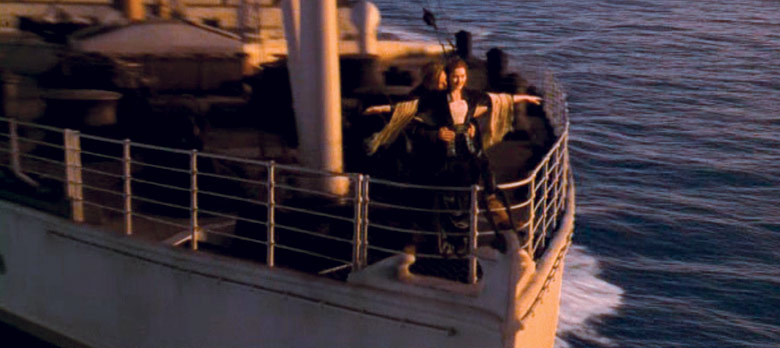
The motion control camera couldn’t go fast enough so we had to have the two performers act at half-speed, essentially. If you watch carefully, however, Kate’s shawl—which is blown by an E-fan—is actually moving at a very high frequency. It’s one of those small things that would have been so easy to deal with today, but that’s the best we could do back then. Chances are, a year later, the decision probably would have been made by the visual effects supervisor to paint out the real costume and put in a CG scarf. I think the fast-moving scarf is still in the movie.

We used orange cels in the lighting, but there was just one light—a 5K. The sun was that bright. Russ had some net in front of it, with gel on it, and he was dropping scrims as the light was changing rapidly. It even changed throughout the shot. What’s amazing, though, was that the sun kind of peeked out as the shot progressed. We almost missed our second take because they were still screwing around with clothespins getting the gels on. As far as the camera we used, I’m guessing it was a Panaflex with a 1,000-foot mag. We were fighting the light, but I would have tried to hold on to a zoom if I could, just to get the focal length right at the last second. But was it zoom or prime? 17 years later I don’t remember.
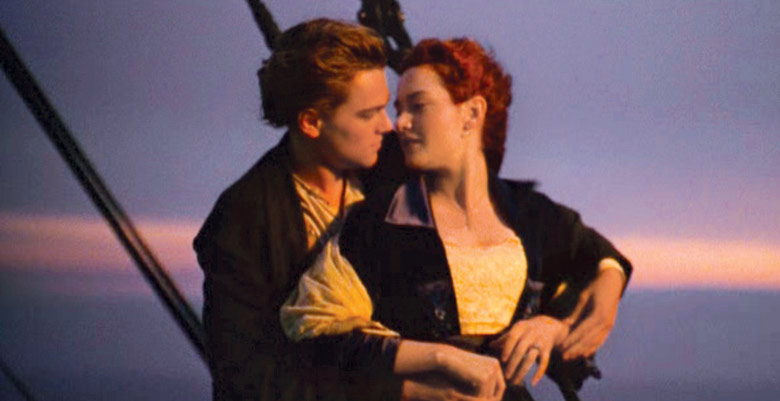
To me, this frame is the quintessential image. It’s a continuation of the shot that began in frames four and five, and resumes in this frame and the next. They’re the real thing in real conditions. We did around two takes in which one was out-of-focus and the other was half out-of-focus. The one that’s half out-of-focus is the one in the movie. Just at the moment it would have been unusable, the 1st assistant camerman managed to pop it in. When we did the 3-D conversion, we started with a 4K master where everything is sharp, you see every grain, and there’s no hiding it there—it’s buzzed. But you know what? Nobody cares. It almost adds to the moment because it gives the shot an overall softness.
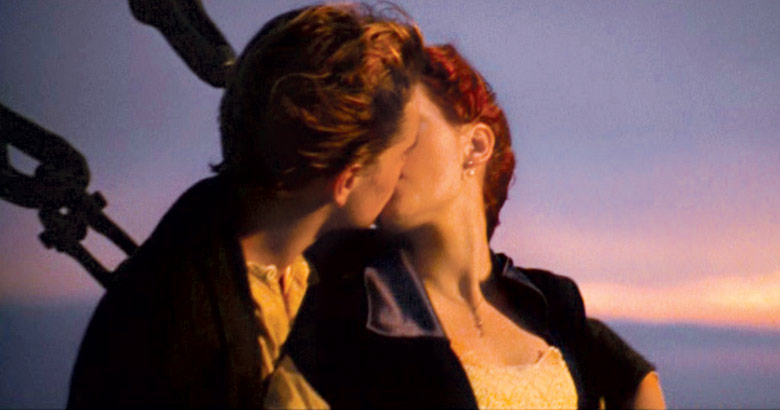
The money shot is this half-in-focus kiss shot, and the kiss itself is what it is. There was no attempt to extend it with closer coverage—it’s just as you see it. In rehearsal I talked about how their lips would first come together and I drew lips on my hands to show them the speed and tentativeness and all. Whether they remembered that a month later, I don’t know. Probably not. But we did rehearse it to that level of forensic detail. I was above in a crane basket dropped in nearby so I could see both them and the camera. I was just out of the sweep of the camera because it came right around and past them and actually wound up just beyond them.
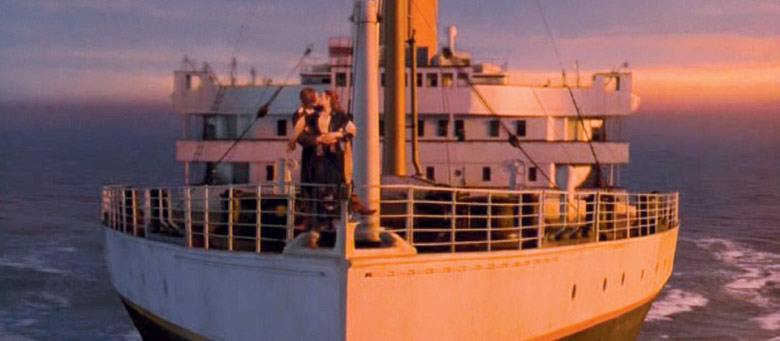
This frame and the following two are all from the same shot, which was done the same way as the earlier wide VFX shot in frames 7 and 8. It’s a live action motion control element of Kate and Leo shot on a green set at Digital Domain. At the beginning, when the shot is very wide, they are a“card”—meaning a live element shot from far back with a longer lens, and then composited into the model of the ship. As we get closer, we morph to their motion control element, which is still composited to the ship model. By the next frame, you’re fully into the live motion control element. Today we’d just do the wide part of the shot with CG doubles.
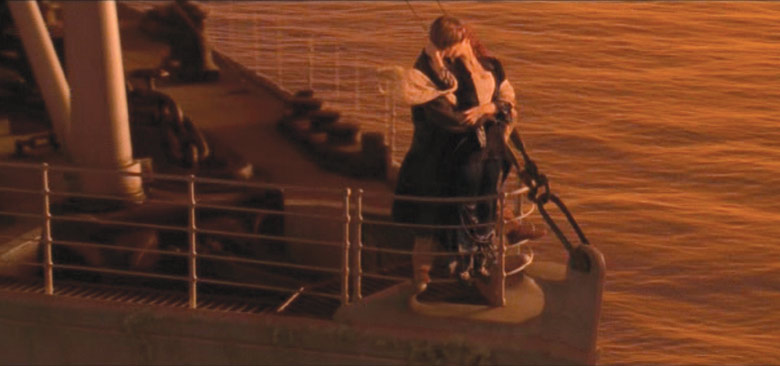
We shot Leo and Kate for this on a greened-out set, and the railing itself was also greened-out with green masking tape. They were a separate photographic element from the ship model that they were composited into, so it was possible to control the timing; they wound up being these sort of ghostly figures that remained the last to go. The color transition is going from the golden orange sunset hues into blue underwater hues—you go through a very neutral, grayish feeling before it becomes more saturated in blue, and that’s partly what creates this sense of a time transition.
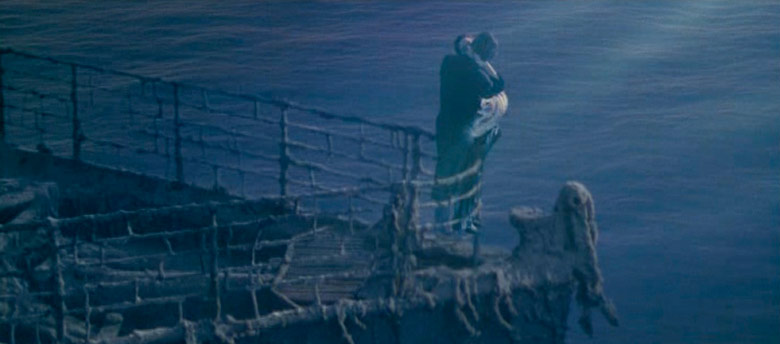
This is obviously a morph transition, where the good miniature of the ship is replaced with the miniature of the wreck. The amazing thing is that, in reality, the wreck itself is still in very good condition around the bow, so the shot is quite accurate. Obviously this was all included in my original script, where there’s an attempt to describe the majesty and the nuance of the entire scene. I recall there was a very specific description of this morph transition to the wreck, and we made detailed storyboards for these last few shots. This was created at Digital Domain and, to me, it’s the most beautiful transition in the film.